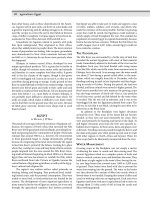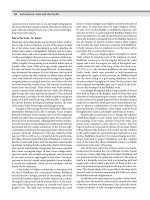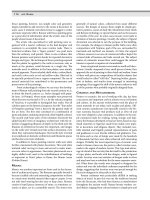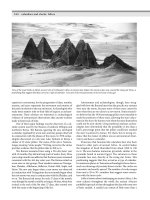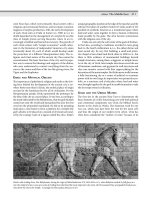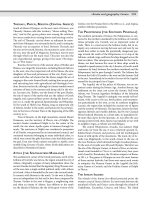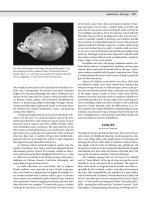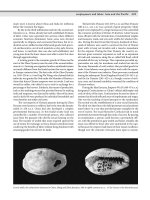Encyclopedia of society and culture in the ancient world ( PDFDrive ) 301
Bạn đang xem bản rút gọn của tài liệu. Xem và tải ngay bản đầy đủ của tài liệu tại đây (70.1 KB, 1 trang )
272
climate and geography: further reading
FURTHER READING
Sigmar Bortenschlager and Klaus Oeggl, eds., The Iceman and His
Natural Environment: Palaeobotanical Results (New York:
Springer, 2000).
Brian Fagan, The Long Summer: How Climate Changed Civilization
(New York: Basic Books, 2004).
Heidi H. Jacobs, Michael L. LeVasseur, Kate Kinsella, et al., Asia
and the Pacific: Geography/History/Culture (New York: Pearson Prentice Hall, 2004).
Keith J. Kirby and Charles Watkins, The Ecological History of European Forests (New York: CAB International, 1998).
Pak Sum Low, ed., Climate Change and Africa (New York: Cambridge University Press, 2005).
Bill Manley, The Penguin Historical Atlas of Ancient Egypt (New
York: Penguin, 1996).
Alan Moorehead, The White Nile (New York: Harper, 1960).
John Harris Paterson, North America: A Geography of the United
States and Canada, 9th ed. (New York: Oxford University
Press, 1994).
Norman J. G. Pounds, An Historical Geography of Europe; 450 b.c.–
a.d. 1330 (Cambridge: Cambridge University Press, 1973).
Neil Roberts, The Holocene: An Environmental History, 2nd ed.
(Malden, Mass.: Blackwell Publishers, 1998).
Richard J. A. Talbert, An Atlas of Classical History (New York: Macmillan, 1985).
Charles Watkins, European Woods and Forests: Studies in Cultural
History (New York: CAB International, 1998).
▶ clothing and footwear
introduction
Very little is known about clothing in ancient times. There
are few original garments that have survived the passing of
the ages. Those that remain in existence are mostly from dry
regions in the Near East. There are almost no examples of
clothing from Europe. Hints about the dress of ancient people have to be taken from depictions of clothing in art and
written sources as well as studies of the disintegrated remains
found at burial sites. Psychologists and sociologists have attempted to identify the motivations that prompted people
to dress themselves. Clothing is not essential for survival in
every part of the world, particularly in warm regions, but
there were several basic reasons for dressing. Clothing was
worn for protection, for decoration, out of modesty, and to
denote status. Ancient people apparently wore clothing for
all of these reasons.
The earliest clothes were animal skins and pieces of
plants, such as leaves and bark. The garments of the ancient
world, with a few exceptions, were draped. The basic form of
much ancient clothing was a length of square, rectangular, or
semicircular fabric draped to create a variety of styles, each
of which was distinctive and characteristic of the particular
culture and period within that culture. These draped garments were fastened together, when fastening was required,
by pins or threads. Heavier garments were required in
northern regions for protection against cold weather, while
lighter-weight fabrics were used in southern regions. By the
start of the Common Era, European peoples dressed chiefly
in wool and linen, while Asian civilizations preferred silk
and cotton clothing.
Ancient people dressed in loincloths, skirts, tunics,
shawls, cloaks, and veils. The skirt, in the ancient world, was
a garment that began at the waist and hung loosely around
the body. Skirts were worn by both men and women and
varied in length. The loincloth was a length of cloth wrapped
in any of several ways to cover the genitals. The tunic was a
simple, one-piece, and typically T-shaped garment, cut with
an opening for the head and arms. Tunics were usually long
enough to cover the trunk and were made in as many different lengths as skirts. Shawls were rectangles, squares or
ovals of fabric that were commonly combined with skirts
or tunics. These ranged from pieces that covered only the
upper body to larger pieces that could be wrapped to make
a complete garment. The veil was a smaller rectangle that
covered the head and, sometimes, part of the upper body.
It was worn exclusively by women. A cloak, worn outdoors,
was a capelike garment tied or pinned around the shoulders. Sandals were the most common type of footwear, with
boots popular in colder climates. Fancy materials and certain colors, such as purple among the Romans, were often
restricted to the elite classes. Decorations often indicated
status or military rank.
AFRICA
BY J USTIN
CORFIELD
The dress throughout Africa during ancient times varied
considerably with the climatic conditions and the status of
the people. Many Egyptian, Greek, and Roman accounts and
images describe the North Africans. There are also records
and images from the travels of Egyptians, Carthaginians,
Greeks, and Romans. Archaeological remains have been recovered from elsewhere in Africa. From this evidence it is
clear that yarn spinning and weaving were done throughout
most of ancient Africa.
Rock art from the Atlas Mountains (modern-day Morocco) dating from as early as 6000 b.c.e. shows people dressed
only in loincloths. Over time, trade led to many changes.
The clothing of Greeks and Romans in northern Africa was
similar to the clothes they wore elsewhere in the Mediterranean region. The standard item of clothing for a man was a
tunic, and a woman wore either a simple or a pleated dress.
Although Greeks and Romans always wore belts, the Carthaginians probably did not, possibly because of the extreme
heat in Carthage and other parts of North Africa during the
summer. Evidence of this style of dress is in the play Poenulus
by Titus Maccius Plautus (254–184 b.c.e.). The character Milphio challenges a Carthaginian merchant, “Hey, you there
without a belt, why have you come to this city?” The Romans
used a belt to hold a purse for their coins, and it is likely that
